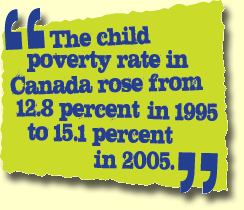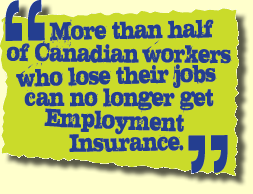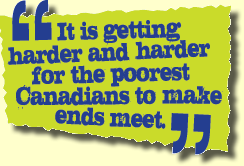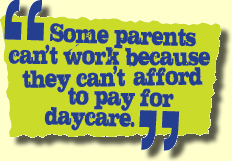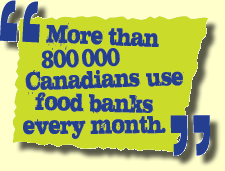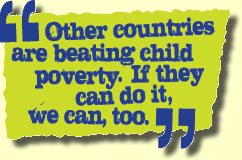

As Canadians, we’re lucky to live in one of the world’s wealthiest countries. Or at least most of us are lucky. According to Statistics Canada, about one in 10 Canadian children don’t share in Canada’s wealth. Their families struggle every day to meet basic needs like food and shelter.
We have enough resources to go around, so how can this happen in a country as rich as Canada? It’s because we aren't doing enough to make sure everybody gets enough.
Broken Promises
For years, Canada has talked about reducing child poverty. In 1989, the government announced that Canada would work “to achieve the goal of eliminating poverty among Canadian children by the year 2000.” But the government didn’t have a plan! More than 10 years past the deadline, child poverty hasn’t declined. In fact, according to the Conference Board of Canada, the child poverty rate in Canada actually rose, from 12.8 percent in 1995 to 15.1 percent in 2005. We must ask the question: why are so many Canadian children living in poverty?
Reason #1: Not Enough Money
Families don’t earn enough income. According to the National Council of Welfare, more than half the children who live in poverty have a parent who works. However, their jobs just do not pay enough to cover food, rent, clothing, and daycare.
For Canadians who lose their jobs, the situation is worse. Employment Insurance is meant to help them get by until a new job can be found. But the government recently changed the rules for collecting Employment Insurance, so more than half of Canadian workers who lose their jobs can no longer get it. Collecting social assistance becomes their only option.
But social assistance doesn’t provide enough money to cover all the bills. According to reports from the National Council of Welfare, as of 2009 a family of four in Vancouver would receive $13 213 in social assistance payments per year. Even with other government payments, such as child benefits, at most the family would receive $21 016. That is far below $34 738 per year, which experts agree is the minimum a family of four living in Vancouver needs to cover all its expenses.
Reason #2: Rising Cost of Living
While the poorest Canadians are earning less money, necessities are becoming more expensive. Food, housing, transportation, heat, and electricity have become more costly in recent years. Most low-income families now spend more than half of their money on rent alone. It is getting harder and harder for the poorest Canadians to make ends meet.
Reason #3: Daycare Is Expensive
Canada has no national affordable daycare program. For most low-income families with young children, daycare is the second biggest expense, after rent. According to a survey in Today’s Parent magazine, in 2010 it cost an average of $551 a month to have a preschooler in daycare across most of Canada. It cost even more in British Columbia, Ontario, and Alberta. Parents in these provinces paid an average of more than $750 a month.
Some families are lucky enough to get a subsidized spot that the government helps to pay for. But these spots are limited, and waiting lists are months or even years long. According to UNICEF, Canada has subsidized daycare spots for fewer than 25 percent of children under three. The result is that some parents can’t work because they can’t afford to pay for daycare.
Hungry Families
To survive, more Canadians are using food banks. According to Food Banks Canada, almost 868 000 Canadians went to a food bank for help in March 2010. That’s a record number. About 38 percent were children. And while food banks do amazing work, they can only do so much. Clients usually get enough food to last about four or five days each month. To get by, some families sacrifice fresh fruits, vegetables, dairy products, and meat because they are too expensive. Sometimes families skip meals. When kids miss breakfast or lunch, it’s harder for them to focus in school and reach their full potential because they’re hungry and can’t concentrate.
The European Solution
Other countries have tackled these problems head-on to fight child poverty. Denmark, Finland, Norway, Sweden, and other European countries have left Canada behind in the fight. They increased their child benefits and welfare payments. They created affordable national child care and housing programs. But most importantly, they made a plan. And today, these countries have child poverty rates below 5 percent, while Canada’s rose to 15.1 percent in 2005.
Canada Needs to Step Up
Canada signed the Universal Declaration of Human Rights more than 60 years ago. Our government made a promise to make sure every Canadian would get enough to eat and would have decent housing and clothing. Every day, the government is breaking its promise to more than one million Canadian children.
The Canadian government needs to make a plan to end child poverty. By setting out clear targets and plans for reaching them, the government can measure its progress each step of the way. Raising the minimum wage, creating affordable housing and child care programs, and paying higher child benefits would help. So would making it easier to get Employment Insurance.
We have to stand up and tell our government to take action. Get informed, and demand action from your member of Parliament. Other countries are beating child poverty. If they can do it, we can, too. We can’t sit back and wait for it to happen. We’ve already seen the results of that—nothing!
